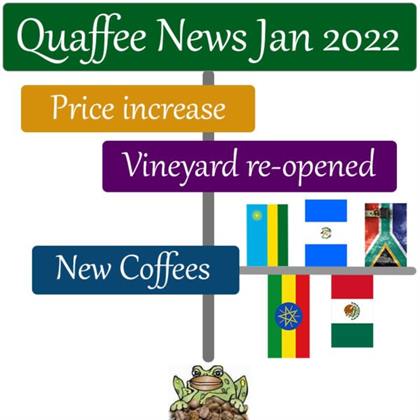Glance Time: 45 sec
Read Time: 7 minutes
To be covered:
- Price increase
- Vineyard reopened
- New coffees
- Rwanda
- New crop Ethiopians
- Guatemalan
- Mexican
- Lockdown?
Price Increase
Our coffee prices are linked to the prices we pay for coffee. What follows is an introduction to the raw coffee (green) pricing structure and why we need to increase our prices.
Three essential categories
There are essentially three levels of raw coffee prices. First is the commodity coffees. Commodities are a publicly-traded future. The traded price determines the price of commodity coffee (learn more about this here…). Commodity coffees go through simple size and quality grading only; taste generally is not a factor. Coffees that do not make the minimum grading are sold below this price, coffees that make the grade sell for this price or this price plus a local premium as per the local government coffee controls. Organic, Fairtrade and other certifications use these coffees and add the appropriate levy on to cover the certification cost.
Above commodity (or c-grade) is what is generally called specialty (or premium) coffee. A maximum number of faults per lot is allowed (besides the basic sizing and quality grading). Once these essentials are met, the coffee is assessed in the cup. A coffee that scores 80 or more (by a panel of at least three certified Q-graders, for arabica at least) is classed as specialty. Pricing of these coffees may be linked to the commodity price plus a premium. Typically, coffees that score 83 or more are the ones we consider specialty, and their price is related to their cup quality. Obviously, these coffees will cost more than commodity coffees, usually starting at least twice the price but typically three times the price. When the commodity price goes up, there are smaller increases here since most quality buyers already purchase these coffees at much higher prices. Farmers and producers who concentrate on these quality-driven coffees have experienced an increase in the demand for their products as more quality-focused roasters have come into the market. A market that has seen some growth in the last decade worldwide, and this direct demand has affected the price, essentially delinking these coffee prices from the c-grade coffee.
The third level of raw coffee cost are the unique coffees. Small lot coffees that are often auctioned off or submitted to competitions. Pricing typically starts five to six times more than commodity coffee and may go to very high prices (dependent on many factors linked to volume, origin and any competitions in which the coffee has been recognized for its quality). These coffees’ prices are directly affected by the demand for the style of coffee being offered.
Market forces
In the last nine months, the commodity price has more than doubled and unusually has stayed on average at least double what it was. We think this is a good thing for most farmers. Unless farms are 100ha or more and are using mechanization, the c-grade price, where it is, currently is probably the minimum it should be. However, market forces dictate prices, and with the bulk of coffee being bought by profit-driven large conglomerates, they have been able to force the coffee price to hover at $1.20 per pound for well over a decade. This stronghold appears to have been broken, driving prices north of $2.40, at least for the last nine months.
Cutting to the bone of the issue
In essence, this means that we need to increase our prices, as the fundamental price has increased. Most affected will be the commodity-based coffees we offer. On our website, these are the 3-star and below coffees.
These coffees we have had to increase by around 25%. Regular consumers of these coffees were already emailed explaining this increase, and there was a post on our site.
Our 4-star coffees are the good quality coffees we mentioned in the second range of coffees. We have always preferred these coffees since they are produced at reasonable volumes by the quality-focused farmer or producer, making a dramatic difference to their lives.
Here, our prices will increase by around 12.5%.
The 5-star coffees we offer have always been provided at our most affordable rate we can. We love these coffees; they are scarce, and what we pay for them directly impacts what we charge for them. At the moment, we have two of these coffees (with one or two on the way) and will not be increasing these prices.
Effective when?
The commodity price linked coffees will be increased first of Feb. The others will be on the first of March.
One concern is the rumblings of a VAT increase. If VAT does increase, we may need to review these increases again, but we suspect that the mentioned increases will stand.
By the way, we have not increased our prices for two years. Covid-19 has hit many of us, and we have survived. We do not take price increases lightly and hope you understand our predicament.
Vineyard roastery reopened
In early December (just as the building industry was shutting down), we had a fire in the Vineyard roastery’s external chimney. With all the Covid-19 restrictions, we had not chased up the regular cleaning of the chimney, resulting in the fire. We are finally ready to roast again at the Vineyard Hotel based roastery. Volumes there are still low, and walk-in business is essentially non-existent. We, however, will still be open there during the week, except for Tuesdays. Sino is there from 8:30 am to 4:30 pm, so pop in taste some of the new coffees we have there.
New coffees
Sourcing coffee in the current market has been quite challenging. We have run out of some of our regulars. Some have been delayed; some we are no longer able to source. So, we have some new coffees. Namely:
-
- Rwandan Intango. Already being roasted and is available at the Vineyard roastery or via the website. This coffee has replaced the popular Migoti Murambi Hill, which we hope to have before July again. Until then, try this coffee. Read more about it here…
- New crop 4-star Ethiopians. We finished our Guji, and our current Yirgacheffe Kochere is almost gone. However, the new shipment has finally arrived, and these coffees should be available in the first half of Feb 202, with the latest prices in effect.
- Guatemalan El Morito. Unfortunately, our source for the Pulcal has been unable to secure Pulcal from Antigua for a while. We are using the El Morito instead in the Vineyard blend, and we will be publishing details and offering it also in the first half of Feb. Watch our socials.
- Mexican. Not going to mention too much about this one, but keep your eye out. Watch our socials. It is a limited quantity, and we think it will go down well.
- Lockdown Blend. Our festive blend that we just made for fun was super popular. So while we still have the components, we are releasing this blend as Lockdown.
A thanks and an update
Quaffee has survived over the last two years thanks to the fantastic support of people that love coffee the way we do. We have never run after the high-volume retail client, preferring to focus on those who love making coffee, enjoying coffee they like, and appreciating all we do. Last year I spoke about us conceivably looking for a little bridging finance to bring in our new season of coffees. We think we may just have saved enough to prevent this. For those that reached out, we appreciate the thought, and perhaps in the future, we will ask you for your generosity around some unique lots we hope to secure in 2022. We are truly humbled to serve all of you that support us. From the bottom of our hearts, thanks.
PS. We have decided only to use our social media to make announcements and share videos and posts we find interesting. So expect the number of posts to be as minimal as possible.



